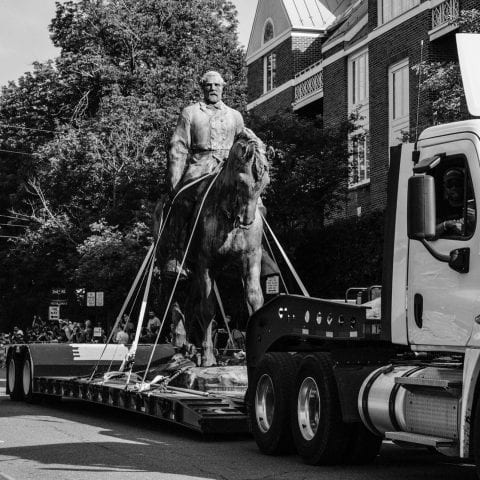“Not a Horse to Put on Airs”: Transforming Monuments to Robert E. Lee

In 1923, a Confederate veteran wrote an indignant letter to the editor to complain that Charlottesville, Virginia’s planned monument equestrian sculpture of General Robert E. Lee not only “signally failed to reproduce General Lee as he actually was,” but that the monument’s restless horse bore no resemblance to Lee’s famed mount, Traveller, who “was not a horse to put on airs.” In 2017, protests about Charlottesville’s planned move of the monument to a less prominent location culminated in the deadly “Unite the Right” rally. But although Charlottesville awarded the sculpture in 2022 to a local nonprofit that plans to melt down its bronze to create a new, more representative monument, a lawsuit by Confederate heritage groups has halted the process.
The struggles over the fate of Charlottesville’s statue are just one example of recent conflicts over monuments to Lee. These monuments sit at the core of some of the most important sites shaping American historical memory, including Arlington National Cemetery (whose graves now surround Lee’s former plantation house) and Stone Mountain (the world’s largest Confederate monument, which is still Georgia’s most-visited tourist attraction). This talk looks at the conflicts between activists, academics, lawyers, and locals to explore the various meanings of Lee (described by the president of Washington and Lee College in 1933 as “one of the world’s noblest losers”) and the circumstances which permit historical sites to shift between these meanings – or stop them from doing so.

Erin L. Thompson, professor of art crime at the City University of New York, holds a PhD in Art History and a JD, both from Columbia. She is an expert in the deliberate destruction of art, analyzing the ways in which this destruction has sometimes harmed and sometimes benefited communities. Her first book, Possession: The Curious History of Private Collectors (Yale University Press) was named an NPR Best Book of 2016. Her second book, Smashing Statues: The Rise and Fall of American Public Monuments, was published by Norton in February 2022. Thompson has spoken about monuments controversies at Oxford, Cambridge, and the Carter Presidential Library, among other venues, and has given interviews about the topic to the New Yorker, New York Times, CSPAN, NBC’s “The Today Show,” NPR’s “All Things Considered,” and many other media outlets. She is also interested in the black market for antiquities and stolen sacred artworks, the legalities and ethics of digital reproductions of cultural heritage, and art made by detainees at the United States military prison camp known as Guantánamo Bay; she curated a travelling exhibit of this artwork (2017-present). Besides traditional scholarly publications, she has written for general audience publications including The New York Times, Washington Post, Hyperallergic, Time, and Smithsonian Magazine, was a Public Scholar of the New York Council for the Humanities from 2015-2018, a Fellow at the Rice University Humanities Research Center from 2017-2018, and is a Fellow at the New York Public Library Cullman Center for the Humanities in 2022-2023.

